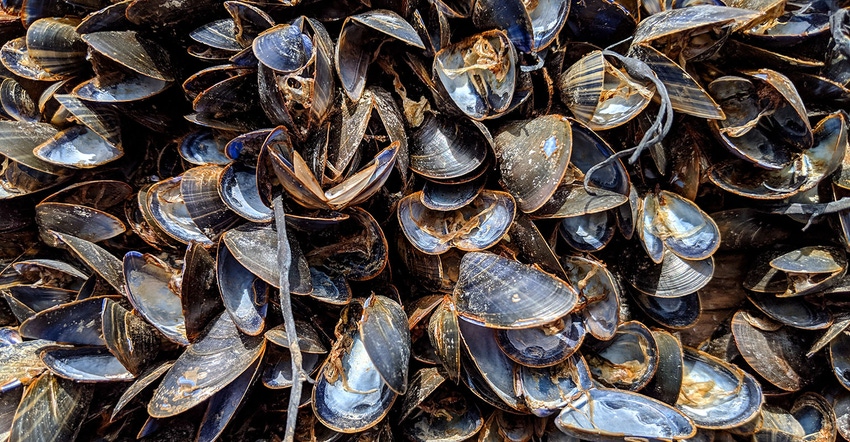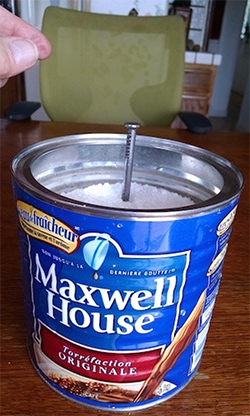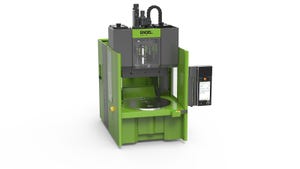Extrusion Basics: A Smart Material Management Strategy
Making the most of your materials is always a good idea, but it’s especially pertinent at a time when resin pricing is volatile.
July 17, 2021

On the British Columbia coast, the “fields” of mussels are being “cooked” by record-breaking heat. My first reaction was, “Are they still edible?” It would be a shame to waste them, I thought, and just leave them to rot. You also may have this material-conserving mentality, at least with regard to plastics. Saving and using materials is the subject of this month’s column, but not untiI I remind you (again) that plastic polymers are not biotoxic, even if there are understandable reasons why so many people want/need to believe they are.
So how do we make the most of our materials, especially in this time of volatile pricing? Here are some suggestions.
|
Why is Allan Griff dropping a nail in a coffee can? You'll have to ask him. |
Take responsible inventories, including scrap/trim. For the latter, note color and other additives, bulk density, grind size, original resin, surface treatment if any, and, if possible, viscosity (melt index) or, for PVC compounds, a torque rheometer curve. For PET, it may be crystallized or have its intrinsic viscosity (IV) raised by solid-state condensation. Dates of scrap/trim generation are important, especially with incompatible additives such as slip and anti-statics that may come to particle surfaces. Ask me about dropping a nail in a coffee can, if you haven’t already seen it in my writings — my e-mail address and phone number are at the end of this article.
Pay attention to how you are storing the scrap/trim you are making now. Is it covered to avoid drop-in contaminants? Are you marking the containers properly? Doing recording and backup? Use containers that are clean or pre-used for the same stuff. If you run a layered product (co-extrusion) you may want to put the scrap in the less-visible layer. Don’t mix materials unless you have to, and then label accordingly.
Define the primary (virgin) resins you use in the same way: Particle size, bulk density, resin product number and maker’s product data page, and viscosity. Get range/limits for purchase specs if you can — it’s not always possible — and test what comes in. If a 0.92 resin can be anywhere from 0.915 to 0.925, that’s very different from 0.919 to 0.921.
Consider modifying the formulation. This will incur opposition from the don’t-change-anything people, who do have a point. But fear of change is sometimes just putting it off or living with a problem. That’s why we sometimes have people do “continuous improvement.” Suggestions need to be justified, and a respectful balance between changers and keepers is both healthy and profitable. (To me, fear of showing fear is a weakness, not a strength, but you have to know what to be afraid of and why.)
Formulation changes may be driven by thermal stability — how much heat a compound can take before an unwanted property change, maybe color or mechanical, occurs. Or the output rate may be limited because running the screw faster may raise melt temperature more than the higher rate can reduce it by lowering residence time. The importance of running faster must be understood to justify changes — if it means more product sold and more income, that might be OK. But if the line isn’t selling full speed anyway, more speed may cause more trouble than it’s worth.
Scrap management also means paying attention to the percentage mixed with new (virgin) resin, which should be as constant as possible. We would like to use the scrap as fast as it’s made, as is done in some sheet and flat-film lines by direct feed back into the hopper. But percentage affects properties, and not all scrap can be handled this way — off-color can’t mix at a high percentage with virgin, nor can weaker product, but off-thickness can.
A bright side: if you get good enough at handling scrap, perhaps even converting it to pelletized and screened compound, you may earn/save by buying scrap from neighboring processors or even resin makers, who need to get rid of their own off grade. I used to do this at an old job, and I can tell you that 50% of 1-melt extrusion grade polyethylene plus 50% of 20-melt molding grade doesn’t always make a 10-melt compromise, even if they are uniformly mixed. Melt temperatures, especially in the head and die, need management (in this case probably cooler, which may mean slower).
Consider modifying the product by slight foaming or the use of fillers, or both. For foaming, you need to deal with nucleation, orientation, color, and maybe heat control — endo- vs exo-thermic vs nonchemical foaming — but that won’t matter much if you’re only reducing density by 10% or so. To add foaming agent (and any other micro-additive), consider concentrates, as uniform mixing is critical both to control uniformity of product and to keep additive costs down.
For fillers, both cost and effect depend strongly on particle shape and size, chemical surface treatment, and, for concentrates, carrier resin type and viscosity at melt temperature compared with base resin viscosity. All “calcium” (which usually means calcium carbonate) is not the same.
Back to the mussels for a moment: It made me smile to think that the French word for mussel, moule, is the same as the French word for an injection- or blow-mold, also a moule. Irrelevant, but it shows I’m not a machine.

Allan Griff is a veteran extrusion engineer, starting out in tech service for a major resin supplier, and working on his own now for many years as a consultant, expert witness in law cases, and especially as an educator via webinars and seminars, both public and in-house, and now in his new audiovisual version. He wrote Plastics Extrusion Technology, the first practical extrusion book in the United States, as well as the Plastics Extrusion Operating Manual, updated almost every year, and available in Spanish and French as well as English. Find out more on his website, www.griffex.com, or e-mail him at [email protected].
No live seminars planned in the near future, or maybe ever, as his virtual audiovisual seminar is even better than live, says Griff. No travel, no waiting for live dates, same PowerPoint slides but with audio explanations and a written guide. Watch at your own pace; group attendance is offered for a single price, including the right to ask questions and get thorough answers by e-mail. Call 301/758-7788 or e-mail [email protected] for more info.
About the Author(s)
You May Also Like





